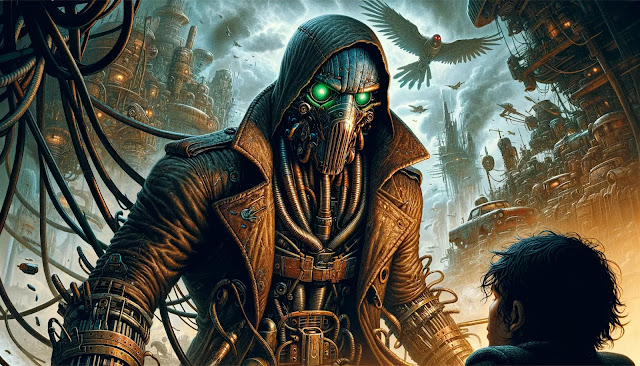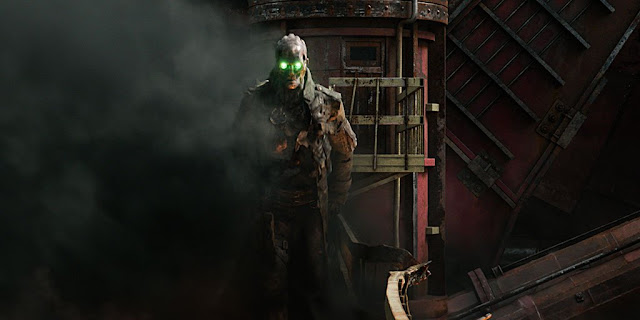
Mortal Engines
In "Mortal Engines," the first novel of Philip Reeve's groundbreaking "Mortal Engines Quartet," readers are introduced to the
post-apocalyptic world of Municipal Darwinism, where mobile cities roam the Earth on wheels, consuming smaller towns for resources.
Central to this narrative is the complex and intriguing character of Hester Shaw, whose personal vendetta and emotional journey after the death of her family and her time adopted by the
Stalker Shrike provide a deeply human element amidst the grandeur of moving cities and steampunk technology.
Driven by Vengeance
Hester Shaw is first introduced as a disfigured, mysterious young woman with a singular focus: to avenge the death of her mother and her own disfigurement at the hands of Thaddeus Valentine, a revered historian of the predatory city of London.
Her determination and resilience are evident in her relentless pursuit of Valentine, showcasing her strength and depth of character from the outset.
Unlikely Alliances and Personal Growth
Hester's journey takes a pivotal turn when she encounters
Tom Natsworthy, a lowly apprentice historian from London, who becomes an unlikely companion after they are both expelled from the city. This partnership, born out of necessity, gradually evolves into a profound bond that challenges and transforms Hester.
Through her interactions with Tom, who is initially naive and idealistic, Hester begins to confront her own deeply ingrained beliefs and motivations. Tom's natural kindness and genuine concern for her well-being offer Hester a glimpse of a life beyond revenge, prompting her to reconsider her path and the possibility of redemption and forgiveness.
Confrontation and Transformation
The climax of "Mortal Engines" sees Hester facing her nemesis,
Thaddeus Valentine, in a confrontation that is as much about confronting her past as it is about seeking justice. This moment is crucial in Hester's arc, serving as a catalyst for her transformation.
It is here that she must choose between the consuming desire for revenge and the new connections and possibilities that have opened up to her through her journey with Tom and others.
Her decision reflects significant growth, moving away from the singular narrative of vengeance to embrace a more complex and nuanced understanding of herself and her place in the world.
Hester Shaw's Evolution
By the end of "Mortal Engines," Hester Shaw emerges as a significantly changed character. Her evolution from a vengeance-driven loner to a character capable of love, trust, and sacrifice underscores the novel's thematic exploration of redemption, resilience, and the human capacity for change.
Hester's relationship with Tom, in particular, highlights her capacity for growth and her eventual openness to experiencing life beyond her initial quest for revenge.
Predator's Gold
In
"Predator's Gold," the second installment of the "Mortal Engines Quartet," Philip Reeve continues the saga of Hester Shaw, a character whose depth and complexity are further explored against a backdrop of steampunk adventure and societal upheaval. This essay examines Hester Shaw's character development in "Predator's Gold," highlighting how her internal struggles, relationships, and actions contribute to her evolution and underscore the novel's thematic concerns.
Through examples from the novel, we can discern how Hester grapples with jealousy, insecurity, morality, and ultimately, personal growth.
Hester Shaw's Emotional Turmoil
Hester's journey in "Predator's Gold" is characterized by her battle with deep-seated insecurities and jealousy, primarily stemming from her relationship with Tom Natsworthy and their encounter with Freya Rasmussen, the leader of Anchorage. Hester's grotesque disfigurement, a constant source of personal angst, feeds her insecurity, especially in the presence of Freya, whom she views as a rival for Tom's affection.
This emotional turmoil is vividly depicted when Hester observes Tom and Freya together, projecting her fears of abandonment and unworthiness. Hester's internal dialogue, laden with self-doubt and suspicion, reveals her vulnerability and the complexity of her character beyond her rugged exterior.
Actions Driven by Fear and Love
Hester's actions throughout "Predator's Gold" are often driven by a convoluted mix of fear and love. A pivotal moment illustrating this is her confrontation with Freya, where Hester's threats are motivated by a desperate attempt to protect her relationship with Tom. This scene highlights Hester's willingness to cross moral boundaries, underpinned by her fear of losing Tom.
Her actions, though propelled by love, often verge on morally ambiguous, showcasing the darker aspects of her character and her struggle to navigate her emotions and decisions responsibly.
Moral Ambiguity and Consequences
The novel does not shy away from presenting Hester's morally questionable decisions, which serve as a critical aspect of her character arc. Hester's contemplation of abandoning Anchorage to its fate, driven by a survival instinct, poses significant ethical dilemmas.
Her actions not only affect her relationship with Tom but also impact the broader narrative, creating tension and conflict. Tom's growing disillusionment with Hester's choices reflects the strain on their relationship and underscores the novel's exploration of morality, loyalty, and the consequences of one's actions.
Confrontation, Growth, and Redemption
Hester's evolution reaches a turning point as she is forced to confront the consequences of her actions. Her journey through adversity, both external and internal, catalyzes a reflective process, leading to acknowledgment and, eventually, growth.
The decision to save Anchorage, despite her initial willingness to betray it, marks a significant departure from her self-preservationist tendencies. This act of redemption signifies Hester's growing sense of responsibility and her capacity for altruism, contrasting sharply with her earlier actions and highlighting her complex journey towards self-improvement.

Infernal Devices
In
"Infernal Devices," the third novel of the "Mortal Engines Quartet," Hester Shaw's character arc continues to evolve amidst the backdrop of a world still rife with conflict and transformation. This section of her journey introduces new dimensions to her character, particularly focusing on her roles as a mother and a partner, while delving deeper into her internal conflicts and the consequences of past actions. Hester's relationship with her daughter Wren, her ongoing struggle with her identity and self-worth, and the choices she makes in the face of new challenges illustrate significant growth and depth in her character.
The Introduction of Motherhood
The novel introduces Hester as a mother to Wren, adding a complex layer to her character. Hester's fierce protectiveness and deep love for Wren are juxtaposed with her fears of inadequacy as a parent.
This is evident when Hester worries about the kind of role model she is for Wren, reflecting on her own violent past and the scars, both physical and emotional, that she carries.
Her desire to provide a better life for Wren, while grappling with her own demons, showcases the duality of her character—torn between her instinctive, sometimes violent tendencies, and her deep-seated yearning for redemption and a peaceful existence.
Facing the Past
Hester's journey in "Infernal Devices" is marked by her confrontation with her past. The return of old enemies and the revelation of secrets force Hester to reckon with the consequences of her earlier actions.
This is particularly highlighted in her interactions with the Stalker Fang (a resurrected
Anna Fang), where Hester is faced with the literal embodiment of her past violence and decisions. Her struggle to protect Wren from the dangers that her own actions have helped unleash underscores the novel's thematic exploration of legacy and the cyclical nature of violence and retribution.
The Struggle for Identity and Redemption
Throughout "Infernal Devices," Hester's struggle with her identity and her quest for redemption are central themes. Her relationship with Tom, strained by their past and by the secrets they keep, serves as a mirror reflecting her internal battles. Hester's actions, driven by a complex mix of love, fear, and desperation, further complicate her quest for redemption.
The novel does not shy away from depicting the moral ambiguity of her choices, such as her willingness to engage in piracy (murder) and deceit to achieve her ends. These actions, while aimed at protecting her family, also highlight her ongoing battle with her darker impulses.
Choices and Consequences
The climax of "Infernal Devices" brings Hester's character arc to a critical juncture. Faced with the ultimate choice between continuing her cycle of violence or embracing a path towards peace and reconciliation, Hester's decisions have far-reaching implications.
Her willingness to make sacrifices for her daughter's safety and her efforts to mend her fractured relationship with Tom illustrate her growth. The novel concludes with Hester taking steps towards atonement, albeit with the understanding that some scars might never fully heal.
A Darkling Plain: The Culmination of Hester Shaw's Journey
In
"A Darkling Plain," the final installment of the "Mortal Engines Quartet," Philip Reeve brings the epic saga of Hester Shaw to a poignant and dramatic conclusion. Throughout the series, Hester has evolved from a vengeful, solitary figure into a complex character grappling with issues of love, redemption, and identity.
The Quest for Redemption
Hester Shaw's narrative in "A Darkling Plain" is heavily marked by her search for redemption. Bearing the weight of her past actions, Hester seeks to reconcile her violent deeds with her desire for a peaceful future. This quest is illustrated through her efforts to protect her family and mend the rifts her actions have caused.
One significant example is her attempt to safeguard Tom and their daughter, Wren, from the dangers that her past has wrought upon them. Her readiness to confront her former allies and enemies alike in a bid to secure peace underscores the depth of her transformation.
The Complexity of Relationships
The novel delves deeply into the intricacies of Hester's relationships, particularly with Tom Natsworthy. Their bond, tested by time, betrayal, and the scars of past battles, faces its ultimate trial. Reeve masterfully explores the nuances of love and forgiveness through their interactions, providing a raw and honest look at the challenges they face together.
Hester's relationship with her daughter Wren also comes to the fore, highlighting her struggle with maternal instincts and the fear of passing on her own flaws and demons. These relationships are central to Hester's journey, reflecting her internal struggle and her aspirations for redemption and love.
Actions and Legacy
In "A Darkling Plain," Hester's actions are driven by a combination of desperation and hope. One of the novel's most compelling examples of this is her confrontation with the Stalker Fang, a pivotal moment that encapsulates her willingness to sacrifice everything for the sake of a better world.
This act, among others, serves to illustrate the extent of Hester's evolution from a revenge-driven outcast to a figure capable of selfless sacrifice. Her actions throughout the novel not only shape the course of events but also cement her legacy within the series' universe.
The Final Resolution
The conclusion of Hester Shaw's story in "A Darkling Plain" is both tragic and fitting, providing a resolution that reflects the series' themes of change, loss, and the possibility of redemption. Hester's ultimate fate, intertwined with the fates of those she loves, underscores the series' exploration of the costs of war and the value of peace. It is a testament to her character's journey from darkness into a more nuanced understanding of herself and her place in the world.
-
The
character arc of Hester Shaw across the "Mortal Engines Quartet" represents a meticulously crafted narrative of transformation, resilience, and redemption. Beginning as a character consumed by vengeance in "Mortal Engines," Hester evolves through experiences of love, loss, and moral quandaries, deeply explored in subsequent novels.
Through her journey, Philip Reeve not only captures the essence of a post-apocalyptic world but also delves into the complexities of the human spirit. Hester's evolution from a vengeful loner to a figure capable of profound love and sacrifice underscores the quartet's thematic richness and its exploration of redemption, identity, and the indomitable nature of the human will to overcome the darkness of the past.
Her story arc, emblematic of the broader narrative's scope and depth, leaves a lasting impact on readers, highlighting the transformative power of human connection and resilience in the face of adversity.

























